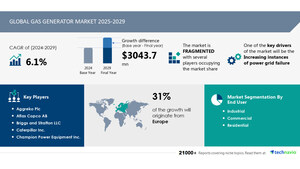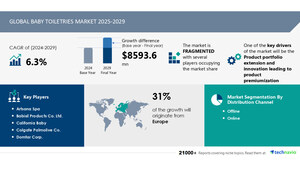NEW YORK, July 5, 2024 /PRNewswire/ -- The global structural health monitoring market size is estimated to grow by USD 2.61 billion from 2024-2028, according to Technavio. The market is estimated to grow at a CAGR of 15.8% during the forecast period. Increasing need for infrastructure maintenance and safety is driving market growth, with a trend towards advent of iot in structural health monitoring. However, rise in budgetary constraints poses a challenge. Key market players include Campbell Scientific Inc., CGG SA, COWI Holding AS, Digitexx Systems Ltd., Geosense Ltd., Hottinger Bruel and Kjaer GmbH, James Fisher and Sons Plc, Kinemetrics Inc., LiveHooah Technologies Pvt. Ltd., MachineSense LLC, Mistras Group Inc., National Instruments Corp., Nova Ventures Group Corp., Ramboll Group AS, RST Instruments Ltd., Sisgeo S.r.l., STRUCTURAL MONITORING SYSTEMS plc, Vinci, Xylem Inc., and Yokogawa Electric Corp..
Get a detailed analysis on regions, market segments, customer landscape, and companies- View the snapshot of this report
Structural Health Monitoring Market Scope |
|
Report Coverage |
Details |
Base year |
2023 |
Historic period |
2018 - 2022 |
Forecast period |
2024-2028 |
Growth momentum & CAGR |
Accelerate at a CAGR of 15.8% |
Market growth 2024-2028 |
USD 2619.2 million |
Market structure |
Fragmented |
YoY growth 2022-2023 (%) |
13.84 |
Regional analysis |
North America, Europe, Asia, and Rest of World (ROW) |
Performing market contribution |
North America at 37% |
Key countries |
US, Germany, China, UK, and Japan |
Key companies profiled |
Campbell Scientific Inc., CGG SA, COWI Holding AS, Digitexx Systems Ltd., Geosense Ltd., Hottinger Bruel and Kjaer GmbH, James Fisher and Sons Plc, Kinemetrics Inc., LiveHooah Technologies Pvt. Ltd., MachineSense LLC, Mistras Group Inc., National Instruments Corp., Nova Ventures Group Corp., Ramboll Group AS, RST Instruments Ltd., Sisgeo S.r.l., STRUCTURAL MONITORING SYSTEMS plc, Vinci, Xylem Inc., and Yokogawa Electric Corp. |
Market Driver
The structural health monitoring market is experiencing significant growth due to the increasing adoption of IoT and Industry 4.0 technologies. IoT networks, which include sensors, thermostats, and actuators, are interconnected over the Internet to collect and evaluate data. This data can be used to optimize energy usage and implement predictive maintenance, resulting in lower operational costs and increased productivity. For instance, Boeing has seen a 13% decrease in annual operational budgets after implementing IoT-based predictive analysis. Third-party outsourcing companies, such as Novotek, are also offering IoT solutions for building management. The demand for IoT in smart buildings is expected to drive market growth. IoT can transform various functions in the structural health monitoring market, such as lighting and refrigeration, fire suppression systems, security and safety alarms, remote monitoring of facilities, and central HVAC. For example, smart energy meters in buildings reduce the need for on-site technicians, and predictive maintenance solutions optimize machine repairs and lower CAPEX budgets. The Edge building in Amsterdam, with approximately 8,000 sensors, is a prime example of IoT's potential in structural health monitoring, providing real-time data on building occupancy, activity patterns, and environmental data. Overall, IoT's ability to improve productivity and energy efficiency is expected to drive market growth in the forecast period.
The Structural Health Monitoring (SHM) market is experiencing significant growth due to the increasing need for reliable infrastructure in urbanizing areas and the role of SHM solutions in assessing the health condition of civil infrastructure. Developments in wireless, real-time measurement technologies have made SHM systems more accessible and cost-effective. However, failures in engineering design and lack of integration with other systems remain challenges. Europe, Brazil, Spain, and Italy are key markets for SHM systems, with cities and infrastructure projects driving the demand. Predictive solutions for damage assessment and performance monitoring are becoming essential tools for ensuring the integrity of structures worldwide. Acellent Technologies and others are leading the way in SHM technology integration and repair solutions. The SHM systems market is expected to continue growing on a global basis, providing essential solutions for the reliability and performance of civil infrastructure.
Discover 360° analysis of this market. For complete information, schedule your consultation - Book Here!
Market Challenges
- Small organizations in growing economies face budget constraints, often relying on investor funds for structural health monitoring services. This can lead to the procurement of low-quality services, increasing maintenance and operation costs, and negatively impacting profitability. Rising labor costs and the need for skilled personnel training further hinder market growth. Additionally, aging assets consume excessive energy, and their replacement and maintenance add to operational costs. Effective structural health monitoring becomes less viable under these high costs. Consequently, budgetary pressures in small organizations will limit the expansion of the global structural health monitoring market during the forecast period.
- The Structural Health Monitoring (SHM) market is seeing growing demand due to the need for infrastructure safety and maintenance. Large machines and equipment, functionally obsolete and structurally deficient bridges, and aging infrastructure require constant monitoring to ensure safety and prevent costly repairs or replacements. Safety regulations and high-profile events like FIFA World Cup, Cricket World Cup, Indian Premier League, Olympics, and even sporting venues in France, highlight the importance of monitoring structures for potential issues. SHM systems use sensors to detect damage and provide real-time data, helping in timely maintenance and reducing costs. The market includes dams, energy, aerospace, mining, defense, and construction sectors. Adoption and implementation of these technologies are a focus for governments and industries alike. Questions remain around costs and the impact of technologies on existing systems and processes. Advancements in hardware and software continue to drive development in this segment.
For more insights on driver and challenges - Request a sample report!
Segment Overview
This structural health monitoring market report extensively covers market segmentation by
- Component
- 1.1 Hardware
- 1.2 Software
- 1.3 Services
- Connectivity
- 2.1 Wired
- 2.2 Wireless
- Geography
- 3.1 North America
- 3.2 Europe
- 3.3 Asia
- 3.4 Rest of World (ROW)
1.1 Hardware- The structural health monitoring market includes the hardware segment, which comprises the physical components and devices used to assess the structural integrity of infrastructure, buildings, bridges, dams, and other civil engineering structures. This hardware segment is crucial as it facilitates data acquisition, sensing various parameters, signal transmission, and information processing. Three primary hardware segments in this market are sensors, data acquisition systems (DAQ), and communication devices. Sensors are fundamental to structural health monitoring systems, capturing data on structural behavior such as strain, vibration, displacement, temperature, humidity, and corrosion. Common sensor types include accelerometers, strain gauges, temperature sensors, displacement transducers, and inclinometers. Data acquisition systems (DAQ) are responsible for gathering, digitizing, and processing data from sensors. They convert analog signals into digital data for further analysis. DAQ systems typically consist of analog-to-digital converters, signal conditioning modules, data loggers, and communication interfaces. Communication devices enable data transmission from the structural health monitoring system to a central monitoring station or cloud-based platform for analysis. These devices may include wired connections like Ethernet or fiber optic cables, as well as wireless technologies such as Wi-Fi, Bluetooth, cellular networks, or satellite communication systems. Together, these hardware components significantly contribute to the effectiveness of structural health monitoring solutions by enabling the monitoring, analysis, and maintenance of critical structures. Advancements in sensor technology, data processing capabilities, and communication systems have fueled the growth and efficiency of this market segment.
For more information on market segmentation with geographical analysis including forecast (2024-2028) and historic data (2017-2021) - Download a Sample Report
Research Analysis
The Structural Health Monitoring (SHM) market encompasses sensors, monitoring systems, and related technologies used to assess the condition and performance of various structures and infrastructure. These include bridges, dams, buildings, stadiums, large machines, airframes, turbines, and even smart cities. The need for SHM systems has grown significantly due to the increasing importance of safety, reliability, and predictive maintenance in infrastructure and public safety. Real-time wireless measurement and damage assessment are key features of SHM systems, enabling early detection of potential failures and reducing costs associated with repairs and downtime. Advancements in hardware and adoption of SHM technologies have led to significant investments in this segment, particularly in the energy industry, where the focus on safety and efficiency is paramount. SHM systems play a crucial role in assessing the health and performance of critical infrastructure, ensuring their continued reliability and safety in the face of natural calamities and other challenges. Civil engineers and other professionals rely on SHM data to make informed decisions regarding maintenance and repair, ultimately improving the overall safety and efficiency of structures and infrastructure.
Market Research Overview
The Structural Health Monitoring (SHM) market is a critical segment of the infrastructure sector, focusing on ensuring the safety and sustainability of structures such as bridges, dams, buildings, airframes, turbines, and large machines. SHM systems utilize sensors, data acquisition, analyzing tools, measuring amplifiers, software, and other hardware to monitor the health of structures in real-time. The need for SHM systems has grown significantly due to the importance of public safety, infrastructure development, productivity growth, and associated economic and social complications. Natural calamities, power outages, communication failures, and collapsing buildings have highlighted the necessity of SHM systems in preventing loss of lives and minimizing economic and social disruptions. SHM systems are also essential for smart cities, as they enable prior warnings and efficient maintenance of infrastructure. Cost-effective constructions, energy harvesting systems, distributed optic fibers, and safety regulations are some of the key trends driving the growth of the SHM market. The market includes various segments, such as transportation projects, buildings and stadiums, vessels and platforms, airframes and wind turbines, and large machines and equipments. Functionally obsolete bridges, structurally deficient bridges, aging infrastructure, and safety regulations are some of the challenges faced by the SHM market. The market is expected to witness significant investments in the coming years, with key applications including infrastructure development, natural disasters, and major events such as the FIFA World Cup, Cricket World Cup, Indian Premier League, and Olympics.
Table of Contents:
1 Executive Summary
2 Market Landscape
3 Market Sizing
4 Historic Market Size
5 Five Forces Analysis
6 Market Segmentation
- Component
- Hardware
- Software
- Services
- Connectivity
- Wired
- Wireless
- Geography
- North America
- Europe
- Asia
- Rest Of World (ROW)
7 Customer Landscape
8 Geographic Landscape
9 Drivers, Challenges, and Trends
10 Company Landscape
11 Company Analysis
12 Appendix
About Technavio
Technavio is a leading global technology research and advisory company. Their research and analysis focuses on emerging market trends and provides actionable insights to help businesses identify market opportunities and develop effective strategies to optimize their market positions.
With over 500 specialized analysts, Technavio's report library consists of more than 17,000 reports and counting, covering 800 technologies, spanning across 50 countries. Their client base consists of enterprises of all sizes, including more than 100 Fortune 500 companies. This growing client base relies on Technavio's comprehensive coverage, extensive research, and actionable market insights to identify opportunities in existing and potential markets and assess their competitive positions within changing market scenarios.
Contacts
Technavio Research
Jesse Maida
Media & Marketing Executive
US: +1 844 364 1100
UK: +44 203 893 3200
Email: [email protected]
Website: www.technavio.com/
SOURCE Technavio

WANT YOUR COMPANY'S NEWS FEATURED ON PRNEWSWIRE.COM?
Newsrooms &
Influencers
Digital Media
Outlets
Journalists
Opted In




Share this article